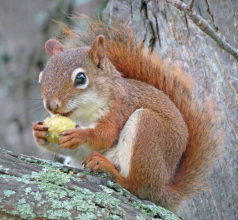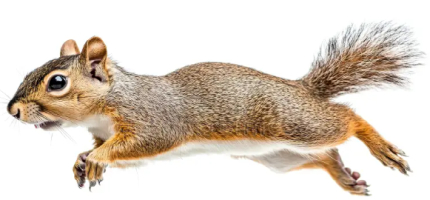 The American red squirrel is known for its reddish coat, which thickens in the fall. Red squirrels' tails are big and bushy, measuring about half the size of their 30 cm long bodies. They get flicked around to intimidate rivals, but the tails are primarily used for balance as the animals jump from tree to tree in wooded areas.
The American red squirrel is known for its reddish coat, which thickens in the fall. Red squirrels' tails are big and bushy, measuring about half the size of their 30 cm long bodies. They get flicked around to intimidate rivals, but the tails are primarily used for balance as the animals jump from tree to tree in wooded areas.
Red squirrels live in mature forests with conifer trees, especially white spruce. They also live in lowland areas like fields. They prefer to nest in tree cavities, and rarely dig burrows in the ground. Red squirrels are diurnal, and don't hibernate; they stay active throughout the winter. They are highly territorial and use vocalizations and scent marking to defend their territory. Red squirrels are asocial, and, except for mating, rarely interact with others of their species. A confrontation between two red squirrels often includes a lot of tail flicking, chattering, and foot stomping. Red squirrels eat seeds, nuts, mushrooms, flowers, fruits, and insects, but prefer the seeds of conifer cones. They store food in the fall, like pine and spruce cones, to eat during the winter. Before storing mushrooms that they’ve foraged, red squirrels have been known to lay them out to dry on tree branches.  Nests are most commonly constructed of grass in the branches of trees or cavities in the trunks of spruce, poplar, and walnut trees. Each individual squirrel has several nests within its territory, and females with young move them between nests. Red squirrels breed in March and April, and have litters of four or five young in late May or early June. Offspring are pink and hairless at birth and weigh about 10 g. Offspring grow at approximately 1.8 g per day while nursing, and reach adult body size at 125 days. Red squirrels have many predators and are susceptible to disease. About half of the population dies each year, and they rarely live past four years old. Chief predators include lynx, bobcat, coyote, great horned owls, hawks, crows, martens, foxes, wolves, and weasels. The red squirrel has adapted to living around humans. Houses, garages and sheds provide safe, warm and comfortable living quarters, with lots of food available in yards and bird feeders. Squirrels can cause significant damage to buildings. They can chew holes in soffits and facia boards, remove insulation and gnaw on electrical wire. Young trees, gardens and bird feeders may be damaged by feeding squirrels. |